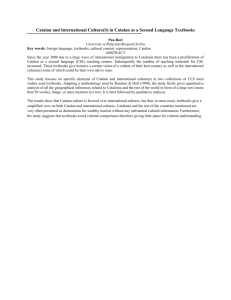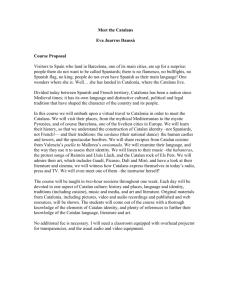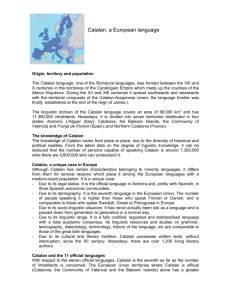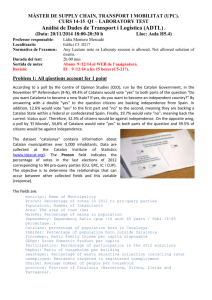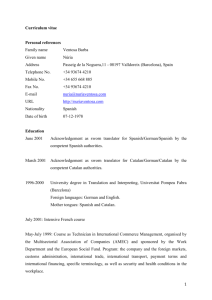A Generalization of the Catalan Numbers
advertisement
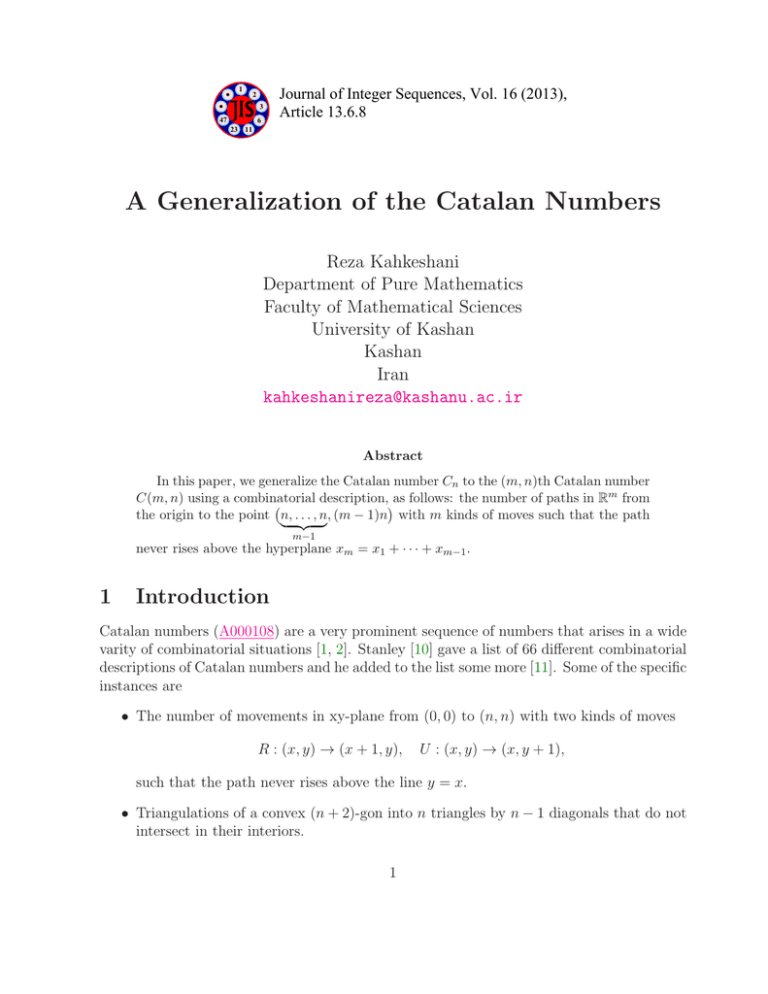
1
2
3
47
6
Journal of Integer Sequences, Vol. 16 (2013),
Article 13.6.8
23 11
A Generalization of the Catalan Numbers
Reza Kahkeshani
Department of Pure Mathematics
Faculty of Mathematical Sciences
University of Kashan
Kashan
Iran
kahkeshanireza@kashanu.ac.ir
Abstract
In this paper, we generalize the Catalan number Cn to the (m, n)th Catalan number
C(m, n) using a combinatorial description,as follows: the number of paths in Rm from
the origin to the point n, . . . , n, (m − 1)n with m kinds of moves such that the path
| {z }
m−1
never rises above the hyperplane xm = x1 + · · · + xm−1 .
1
Introduction
Catalan numbers (A000108) are a very prominent sequence of numbers that arises in a wide
varity of combinatorial situations [1, 2]. Stanley [10] gave a list of 66 different combinatorial
descriptions of Catalan numbers and he added to the list some more [11]. Some of the specific
instances are
• The number of movements in xy-plane from (0, 0) to (n, n) with two kinds of moves
R : (x, y) → (x + 1, y),
U : (x, y) → (x, y + 1),
such that the path never rises above the line y = x.
• Triangulations of a convex (n + 2)-gon into n triangles by n − 1 diagonals that do not
intersect in their interiors.
1
• Binary parenthesizations of a string of n + 1 letters.
• Binary trees with n vertices.
The solution to these problems is the nth Catalan number
2n
1
,
Cn =
n+1 n
and the sequence C0 , C1 , C2 , . . . , Cn , . . . is called the Catalan sequence.
There have been many attempts to generalize the Catalan numbers. Probably the most
important generalization consists of the k-ary numbers or k-Catalan numbers, defined by
1
1
1 kn
kn + 1
kn
k
Cn =
=
=
,
kn + 1
n
(k − 1)n + 1 n
n n−1
where k, n ∈ N. Clearly,
Cn2 = Cn . The k-good paths (below the line y = kx) from (0, −1)
to n, (k − 1)n − 1 , staircase tilings and k-ary trees are structures known to be enumerated
by k-ary numbers [5, 6, 8, 10]. Moreover, Kim [7, Thm. 2] showed that Cnk is the number of
partitions of n(k − 1) + 2 polygon by (k + 1)-gon where all vertices of all (k + 1)-gon lie on
the vertices of n(k − 1) + 2 polygon. Gould [3] developed a generalization that has both the
Catalan numbers and the k-Catalan numbers as special cases, defined as
a
a + bn
An (a, b) =
,
n
a + bn
and showed the following convolution formula for these sequences:
n
X
Ak (a, b)An−k (c, b) = An (a + c, b).
k=0
These numbers are also known as the Rothe numbers [9] and Rothe-Hagen coefficients of the
first type [4]. Clearly, An (1, 2) = Cn and An (1, k) = Cnk .
We know that one of the interpretations of the Catalan numbers is the movements in R2
with two kinds of moves such that the path never rises above the line y = x. In this paper, a
new generalization of the Catalan numbers using this interpretation is introduced. Consider
m kinds of moves in Rm such that they are one unit parallel to the positive
axes. We show
that the number of paths from the origin to the point n, . . . , n, (m − 1)n using these moves
| {z }
m−1
such that the path never rises above the hyperplane xm = x1 + · · · + xm−1 is
1
2n(m − 1)
.
n(m − 1) + 1 n, . . . , n, n(m − 1)
| {z }
m−1
We call this number the (m, n)th Catalan number C(m, n). Clearly, C(2, n) is the ordinary
nth Catalan number Cn .
2
2
Generalization
In this section, we prove the our main theorem. We show that the generalized Catalan
numbers C(m, n) are given by
1
2n(m − 1)
.
n(m − 1) + 1 n, . . . , n, n(m − 1)
| {z }
m−1
Theorem 1. Let Rm be the m-dimensional vector space. Consider
R1 : (x1 , x2 , . . . , xm ) −→ (x1 + 1, x2 , . . . , xm ),
R2 : (x1 , x2 , . . . , xm ) −→ (x1 , x2 + 1, . . . , xm ),
..
.
Rm : (x1 , x2 , . . . , xm ) −→ (x1 , x2 , . . . , xm + 1),
be m kinds of moves in Rm (i.e., Ri denotes the move one unit parallel to the xi -axis in
the positive direction). Then the number of paths from 0 = (0, . . . , 0) to the point N :=
| {z }
m
n, . . . , n, (m − 1)n using the moves R1 , R2 , . . . , Rm such that the path never rises above the
| {z }
m−1
hyperplane xm = x1 + · · · + xm−1 is
1
2n(m − 1)
.
n(m − 1) + 1 n, . . . , n, n(m − 1)
| {z }
m−1
Proof. We call a path from 0 to N of n R1 ’s, n R2 ’s, . . ., n Rm−1 ’s, and (m − 1)n Rm ’s
acceptable if the path never rises above the hyperplane xm = x1 + · · · + xm−1 and unacceptm
able otherwise. Let Am
n and Un denote the number of acceptable and unacceptable paths,
respectively. It is easy to see that each path from 0 to N corresponds to an arrangement of
n R1 ’s, n R2 ’s, . . ., n Rm−1 ’s, and (m − 1)n Rm ’s. Then
2n(m
−
1)
!
m
.
Am
n + Un =
m−1
n!
n(m − 1) !
Now, consider an unacceptable path and its arrangement r1 , r2 , . . . , r2n(m−1) , where ri ∈
{R1 , R2 , . . . , Rm } indicates the ith step of the path. Since the path rises above the hyperplane, there is a first t such that the number of Rm ’s in r1 , . . . , rt exceeds the sum of the
numbers R1 , R2 , . . . , Rm−1 . Moreover, rt = Rm . We only change rt+1 , . . . , r2n(m−1) the part
of the path after the crossing in the arrangement as follows: Mark all the positions of the
Rm ’s in that part of the path and fill those positions with the sequence (in order) consisting
of all but the last of the non-Rm ’s. Then replace those non-Rm ’s that have been used in
3
the replacement with Rm ’s. Here is an example: let m = 3, n = 2 and the path be given
by R1 R3 R2 R3 R3 R1 R2 R3 . Then t = 5, and the part of the path to be modified is R1 R2 R3 .
There is just one position of the Rm ’s, so we replace R3 with R1 , and then fill the R1 R2 with
R3 R3 to obtain the modified sequence R1 R3 R2 R3 R3 R3 R3 R1 . The resulting arrangement
′
′
′
r1 , r2 , . . . , r2n(m−1) is an arrangement of (m − 1)n + 1 Rm ’s, n R1 ’s, . . ., n Ri−1 ’s, n Ri+1 ’s,
. . ., n Rm−1 ’s, and n − 1 Ri ’s for a 1 ≤ i ≤ m − 1. It is not difficult to see that this process
is reversible:
r1 , r2 , . . . , r2n(m−1)
m
∗, ∗, . . . , ∗, Rm |
∗, ∗, . . . , ∗
|
{z
}
| {z }
rRm ’s,
r−1R1 ,...,Rm−1 ’s.
(m−1)n−rRm ’s,
(m−1)n−r+1R1 ,...,Rm−1 ’s.
∗, ∗, . . . , ∗, Rm
|
{z
}
rRm ’s,
r−1R1 ,...,Rm−1 ’s.
m
|
∗, ∗, . . . , ∗
| {z }
(m−1)n−r+1Rm ’s,
(m−1)n−rR1 ,...,Rm−1 ’s.
m
′
r1 , r2 , . . . , r2n(m−1)
′
′
Hence, there are as many unacceptable arrangements as there are arrangements of (m−1)n+1
Rm ’s, n R1 ’s, . . ., n Ri−1 ’s, n Ri+1 ’s, . . ., n Rm−1 ’s, and n − 1 Ri ’s for a 1 ≤ i ≤ m − 1. Then
2n(m − 1) !
m
.
Un = (m − 1) m−2
n!
(n − 1)! n(m − 1) + 1 !
So,
Am
n
2n(m − 1) !
2n(m − 1) !
− (m − 1)
= m−1
n!
n(m − 1) !
n!m−2 (n − 1)! n(m − 1) + 1 !
1
2n(m − 1) !
m−1
= m−2
−
n!
(n − 1)! n(m − 1) ! n n(m − 1) + 1
2n(m − 1) !
= m−1
n(m − 1) + 1 !
n!
2n(m − 1)
1
.
=
n(m − 1) + 1 n, . . . , n, n(m − 1)
| {z }
m−1
We denote Am
n in the above proof by C(m, n). The first few generalized Catalan numbers
are evaluated to be
4
n\m
3
4
5
0
1
1
1
1
4
30
336
2
84
11880
3603600
3
2640
8168160
76881235200
4
100100
7207615800
2229760743210000
4232592
7336632122820
77015151194691790080
5
6
192203088
8193001579963200
2978057806800232994982144
7
9178678080
9763825599821779200
124625746332992720112321024000
8 455053212900 12209602888667136003480 5529032167369807343550830945418000
3
Acknowledgments
The author would like to thank the referee for his/her valuable comments and suggestions
which have improved the clarity of the proof of the Theorem 1. This work is partially
supported by the University of Kashan under grant number 233437/3.
References
[1] R. A. Brualdi, Introductory Combinatorics, 5th ed., Prentice-Hall, 2009.
[2] R. P. Grimaldi, Discrete and Combinatorial Mathematics, 5th ed., Addison-Wesley, 2004.
[3] H. W. Gould, Combinatorial Identities, Morgantown, West Virginia, 1972.
[4] H. W. Gould, Fundamentals of Series, eight tables based on seven unpublished
manuscript notebooks (1945–1990), edited and compiled by J. Quaintance, May 2010.
Available at http://www.math.wvu.edu/~gould/.
[5] S. Heubach, N. Y. Li, and T. Mansour, Staircase tilings and k-Catalan structures, Discrete Math. 308 (2008), 5954–5964.
[6] P. Hilton and J. Pedersen, Catalan numbers, their generalization, and their uses, Math.
Intelligencer 13 (2) (1991), 64–75.
[7] D. Kim, On the (n, k)-th Catalan numbers, Commun. Korean Math. Soc. 23 (2008),
349–356.
[8] I. Pak, Reduced decompositions of permutations in terms of star transpositions, generalized Catalan numbers and k-ary trees, Discrete Math. 204 (1999), 329–335.
5
[9] S. L. Richardson, Jr., Enumeration of the generalized Catalan numbers, M.Sc. Thesis,
Eberly College of Arts and Sciences, West Virginia University, Morgantown, West Virginia, 2005.
[10] R. P. Stanley, Enumerative Combinatorics, Vol. 2, Cambridge University Press, 1999.
[11] R. P. Stanley, Catalan addendum, preprint, May 25 2013.
Available at http://www-math.mit.edu/~rstan/ec/catadd.pdf.
2000 Mathematics Subject Classification: Primary 05A19; Secondary 05A10, 05A15.
Keywords: Catalan number, path.
(Concerned with sequence A000108.)
Received March 16 2013; revised version received July 3 2013. Published in Journal of
Integer Sequences, July 30 2013.
Return to Journal of Integer Sequences home page.
6

